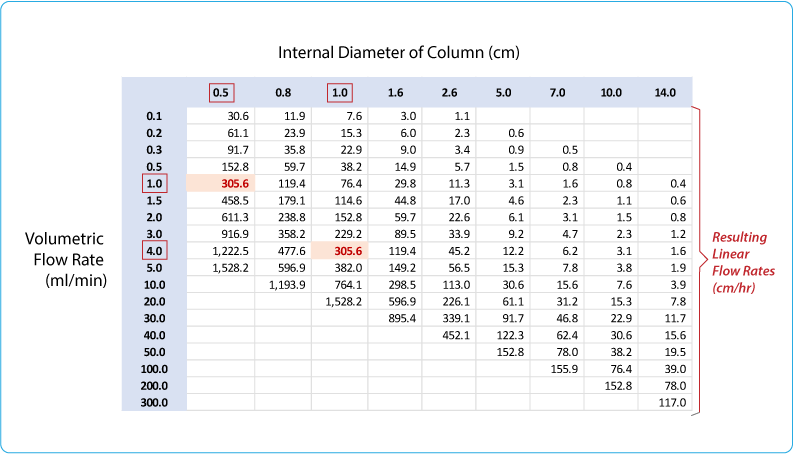This article looks at how calculating the linear flow rate of your column is a useful tool when you are planning to scale up your purification. It shows how to calculate the linear flow rate from the volumetric flow rate of a small column, and then how to use that linear flow rate to calculate the equivalent volumetric flow rate to use when scaling up onto a larger column.

So why is linear flow rate useful?
Scale-up is often required with protein purification chromatography. Preliminary runs are optimized on small columns before larger amounts of product are purified on larger columns. Because protein purification is usually performed in volume mode and not time, when scaling up it is easier to calculate the extra flow rate required for the larger column using a Linear Flow Rate, at cm/hour. This takes into account the increase in the cross-sectional area of the larger column so that it will have identical flow characteristics to the small column.
The Linear flow rate of a column is easy to calculate. Just take the volumetric flow rate of your column in ml/min, divide that sum by the cross-sectional area of the column in cm², and then multiply it by 60.

For example, a column with an internal diameter (i.d.) of 0.5 cm will have a cross-sectional area of 0.0625 cm². If you are running this column at 1 ml/min (the volumetric flow rate) it will have a linear flow rate of 305.6 cm/hr

So now if you want to scale up the run from your column above you will need to use the calculated linear flow rate to find out the volumetric flow rate at which you should run the larger column.

For example, if you want to scale up to a column with a 1.0 cm i.d. it will have a cross-sectional area of 0.25 cm². Multiply this by the linear flow rate of your previous column, in this case, 305.6 cm/hr, and then divide the sum by 60, and you will get an equivalent volumetric flow rate of 4.0 ml/min.

The table below illustrates the calculation that has just been completed above, with a column of 0.5 mm i.d., run at 1 ml/min having a linear flow rate of 305.6 cm/hr, which is the same as the chosen scale-up column of 1.0 mm i.d. run at 4.0 ml/min.

The table below lists popular linear flow rates, with these rates being used to determine volumetric flow rates when scaling up. For instance, in the example used above the column of 0.5 cm i.d. run at 1 ml/min was calculated to have a liner flow rate of 305.6 ml/min, which was equivalent to a column of 1.0 cm i.d. running at 4 ml/min. Now by looking at the table below it can also be seen that the same linear flow rate of 305.6 cm/hr can be achieved on columns of 5.0 and 10.0 cm i.d. by running them at 100 and 400 ml/min respectively.

General note:
Using the same linear flow rate of a small column on a larger column to reproduce a similar chromatographic profile will only work if the media used is of the same type and particle size. Also, ideally, the columns used should be of the same length.
For PDF copies of these tables take a look at our Conversion Tables and Useful Links page.